The golden eagle is found across North America and is the largest bird of prey found in the United States. Golden eagles occur in the greatest numbers from Alaska southward throughout the mountain and prairie habitat of the West and into Mexico. They occur in lower numbers to the east across Canada, the Great Lakes states, and the Appalachian Mountains of the eastern United States. Golden eagles have caused livestock losses and there have well-been documented cases of golden eagles taking mule deer and pronghorn antelope fawns.
Golden eagle prey consists primarily of small mammals such as prairie dogs, rabbits and ground squirrels, but they will consume birds and reptiles when they can catch them. Large mammals are fair game too. Golden eagles sometimes attack large mammals. Mule deer and pronghorn of all ages have been observed being attacked or killed by eagles. In fact, documented kills of bighorn sheep, coyotes, bobcats, and foxes being killed exist. They also eat carrion.
Many ranchers are not fond of golden eagles. They occasionally kill calves, sheep, pigs and goats. Although attacks on animals that weigh more than about 35 pounds are uncommon, they are not unheard of. The photos below show an adult golden eagle attacking and killing a pronghorn antelope near Rawlins, Wyoming. It was assumed that the pronghorn was not healthy, and the photos are quite gruesome, but they do show the ability of the amazing ability and tenacity of the golden eagle.
As the photos show, golden eagles grab deer and pronghorn anywhere on the head, neck, or body, frequently grasping from the front or side. They kill adult animals with numerous talon stabs into the upper ribs and back. Their feet and talons are well adapted to closing around the backbone, with the talons puncturing large internal arteries, frequently the aorta in front of the kidneys.
The major cause of death is shock produced by massive internal hemorrhage from punctured arteries or collapse of the lungs when the rib cage is punctured. Young animals die from shock and loss of blood as they are eviscerated as golden eagles grab them and simply start eating. Where eagles prey on domestic animals, they usually take the young, but some eagles become persistent predators of livestock as large as 500 pounds. Nature is both cruel and amazing. The golden eagle because of regulations and sound wildlife management practices, but it’s easy to see how this species can have a huge impact livestock producers.
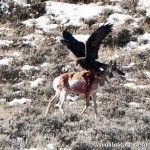
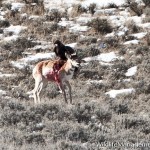
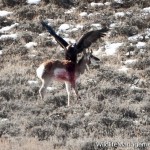
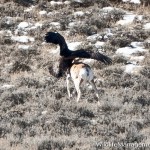
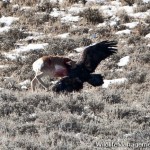
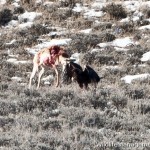
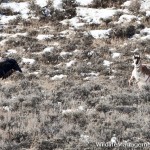
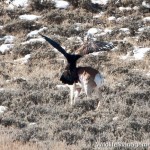
I was the person that photographed the eagle and antelope. I was about 1,850 feet away, reason for the poor quality. The first photo (eagle flying away) in the series should be the last. The antelope got away from the eagle. Two hours later the antelope was lying in some sage with two eagles on a power pole near by. Two days later I checked the area and there was no evidence of a kill, no antelope, no birds.